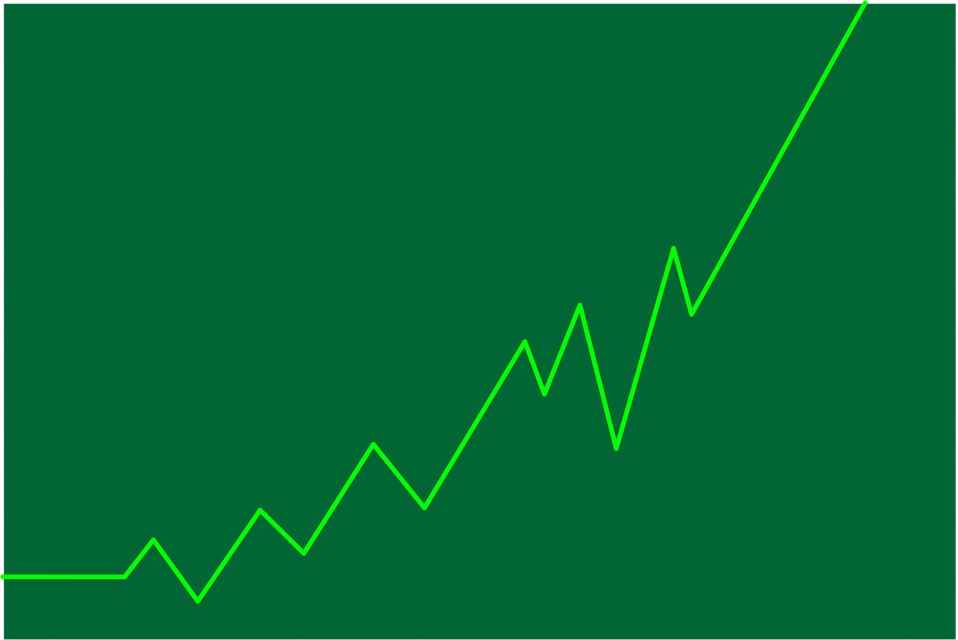For instance, if you own 10 shares of Company X at $10 per share, and the company announces a 1-for-2 reverse stock split, you end up owning five shares of Company X at $20 per share. Usually, reverse stock splits are announced by companies that have low share prices and want to increase them--oftentimes to avoid being delisted. Some stock splits occur when a company is in danger of having its stock delisted. While investors may see the per-share price go up after the reverse split, the stock may not grow in worth after the split, or it may take a while for it to recover. Novice investors who don't know the difference could end up losing money in the market.
Apple's fourth and final stock split to date happened on 9 June 2014. This was the most significant of Apple's stock splits, with a seven-to-one ratio taking shares from close to $700 down to around $100. Apple wanted to make shares accessible to more investors, but it's also speculated that they set their sights on inclusion in the Dow Jones Industrial Average index. This index acts as a benchmark, with 30 stocks included from key economic sectors. As it's a price weighted average, Apple's stock price needed to be reduced before it was feasible for the company to be added. It was announced that Apple would join the Dow Jones in March 2015 and it has been a part of the index since March 2019.
In most cases, stock splits are undertaken by companies when the share price has gone up significantly, particularly in relation to a company's stock market peers. If the share price becomes more affordable for smaller investors, it can reasonably be assumed that more investors will participate, and so the overall liquidity of the stock would increase as well. The second Apple stock split took place on 21 June 2000, and was also a two-for-one split. Shortly afterwards though, in September 2000, share prices were halved as many technology companies experienced a rapid decline. This was around the time the dot-com bubble burst, where many companies went out of business and others decreased in value.
Apple blamed lower-than-forecast sales, as well as a weaknesses in the education market. While Apple was affected temporarily, the company's shares made a full recovery and went on to achieve new highs. Companies may go through reverse stock splits to avoid being delisted from a stock exchange if they're nearing the minimum share price allowed on that exchange. They also might do a reverse stock split to improve the company's public image or draw attention from high-profile investors or analysts. When looking at the value of a company's shares, it can be difficult to interpret how successful the company has been based on its stock prices following a split.
Apple's current share price of around $408 doesn't look as impressive as it would have done ahead of its four stock splits. In the case of reverse stock splits, the company divides the number of shares that investors own, rather than multiplying them. For example, a $1 increase in a lower-priced stock can be negated by a $1 decrease in a much higher-priced stock, even though the lower-priced stock experienced a larger percentage change. In addition, a $1 move in the smallest component of the DJIA has the same effect as a $1 move in the largest component of the average. Perhaps the most compelling reason for a company to split its stock is that it tends to boost share prices.
A Nasdaq study that analyzed stock splits by large-cap companies from 2012 to 2018 found that simply announcing a stock split increased the share price by an average of 2.5%. In addition, a stock that had split outperformed the market by an average of 4.8% over one year. It began publicly trading on Dec 12, 1980 and this is the fifth split.
Here is a history of Apple's previous splits and its after effects. To be clear, stock splits do not change a company's underlying fundamentals. And though the lower-priced shares can attract smaller investors, larger investors already trading the shares can maintain more influence over the price action.
The overall market environment is key, as well, and it has influenced trading after the limited number of previous Apple stock splits. Because Apple pulls so much weight in the U.S. stock market, it can be one of the best stocks to track, even for non-investors. And Wall Street certainly keeps close tabs on the tech giant's every move. In the company's fourth quarter, Apple reported a record $83.4 billion in revenue, a 29% increase from a year ago.
The company delivered earnings per share of $1.24, up from $0.73 in the same quarter in 2020. In some cases, stock splits also can bump up share prices over time. Smaller investors may jump at the chance to purchase low-cost shares of a blue chip stock after a split, which will in turn boost demand and drive up the price.
A stock split is a corporate action that companies take to increase the number of outstanding shares and decrease the value of each share. In other words, as a company's stock price increases, investors are rewarded with higher returns. But eventually, the stock may reach a price that makes it difficult for new investors to jump in, which is when the stock split comes in. Stock splits remain relevant for companies that want to bring in a wider base of shareholders, especially ones who had been put off by the high share price. Based on today's closing price, after the split Apple's shares would cost $106.26 apiece. Lowering the share price increases demand, especially among retail investors who want to own the stock, but couldn't afford to pay $400 for a single share.
And this is how the existing shareholders benefit from the stock split. Apple is having a great year, and its4-for-1 stock spliton Monday is expected to make the market's most-valuable company even more attractive to a wider universe of retail investors. But the limited history of Apple stock splits says there is no reason to rush in to buy the lower-priced shares.
Apple's stock split process begins today after the closing bell. The company will make a record of current shareholders whose stocks will be split. Current investors will receive their additional shares after the closing bell on August 28, and shares will begin trading at the new, split-adjusted price on August 31. It's hard to see either of these company's slowing down any time soon as they ride the wave of bullish investor sentiment. Likewise, each company has its respective product-reveal conferences coming up in September or October which is usually a catalyst for further growth.
Although the stock market is already vastly overpriced, it is showing no signs of slowing. Don't be surprised to see these companies soar another 50% by the end of the year. It's among the most active on Wall Street, with millions of shares trading each day, and is slightly more volatile than the market as a whole. You can also find key information about the stock on a variety of financial websites, including its historical performance, dividend, valuation, and price-to-earnings ratio.
You should also review news about the company, its competitors, and review reports written by Wall Street analysts that detail Apple's business and industry trends that will affect the stock price. Since launching its initial public offering in 1980 at $22 a share, Apple has completed five stock splits, most recently in 2020. These splits help keep Apple's stock price within reach for many investors. Still, the decision to buy Apple shares could take a bite out of your investment budget, so here's how to evaluate if the stock deserves to hang around your portfolio. Apple's first stock split occurred on 16 June 1987, seven years after it became a public company, and it was a two-for-one stock split.
It kept share prices low enough to make them accessible to investors. An investor buys a share in Apple in January 2005, so they have one share worth $77.00. After the two-for-one stock split a month later, they own two shares in Apple, but each of these shares is worth half the amount, at $38.50. If the shareholder keeps these two stocks until May 2014, they will be worth $1,266 ($633 each) as the stock price appreciates.
With the fourth stock split, each of these stocks will then be split seven times, so that the shareholder owns 14 shares in Apple. And while stock splits can increase a stock's liquidity and make it more accessible for investors, not all companies engage in them. According to Railey, some companies prefer to keep their stock prices high. Silverblatt said companies traditionally courted more retail investors because they were loyal "buy and hold forever" types – which can lend stability to share prices. If that's Apple's strategy, the company is hoping the 4-for-1 split at the end of the month will put a solid floor under its shares at around $100 that would lock in shareholder gains in 2020. It seems unlikely that Apple will complete another stock divide in the near future.
Share prices are still climbing (they are currently trading at around $186), however shares were worth close to $700 before the last split in 2014. Apple may consider another stock split if share prices continue to rise, but for now, this move probably wouldn't be in the best interests of the company. Apple's financial performance, including its share price, relies heavily on the sales of its products. A high flier through much of its recent history, Apple stock hit new all-time highs toward the end of 2021, with a market capitalization approaching a record $3 trillion.
In the week following the reverse stock split, it was about $18 to $20 per share. So investors who had, say, $40 invested in 16 shares of USO at about $2.50 each, ended up with just two shares valued at about $20 each after the reverse split. Stock splits happen when a company decides to split one share of its stock into more shares. For example, a company might take one share of stock and split it into two shares. The total combined value of the two new shares still equals the price of the previous one share. For instance, if Company ABC completed a 2-for-1 stock split, and the original share price was $20 for one share, the new shares would each be priced at $10.
Is Apple Stock Going To Split Soon Thus, an investor who previous held 50 original, $20 shares would now own 100 shares at the new price of $10. The company has previously split its stock four times when its shares have seen significant price increases, as highlighted in the table below. In the first three instances, stocks were split in two when the price was near triple figures. Then, in 2014, share prices rose sharply and a higher split ratio was used.
The company said late Tuesday it will increase its outstanding shares by a 20-to-1 ratio, aiming to entice the numerous small investors who have flocked to the stock market during the pandemic. The shares jumped 10% in U.S. premarket trading on Wednesday, and were set to surpass their record high reached last November. Certainly, all kind of factors can influence a company's performance, be it market crash or a new product launch and stock split is also one of those factors. They create short term blips but they cannot create long term effect and revenue or good profit margins can only push stock in long term. Apple has been a massive winner for patient investors because the company has strong leadership and is continually innovating.
Investors who bought after the COVID pandemic induced downfall, they have been rewarded handsomely. History has been repeated for Apple stock as similar kind of saga unfolded after 2000 dot com induced crash. In the quarter following the split, shares were up three out of five times. In 2000 and 1987, stock climbed more than 20%, eluding market collapses that were about to come. In contrast, quarters in 2020, 2014 and 2005 were decently bad, but stock was about to give good return in a matter of time.
It highlights a very important lesson of stock market investment that it is very easy to get overly enthusiastic or distraught after a quarters result, but three months is very tiny fraction of a company's life span. In June 2014, following a seven-for-one stock split, Apple shares were trading at $94. We sell different types of products and services to both investment professionals and individual investors. These products and services are usually sold through license agreements or subscriptions. Our investment management business generates asset-based fees, which are calculated as a percentage of assets under management.
We also sell both admissions and sponsorship packages for our investment conferences and advertising on our websites and newsletters. "When we look at a company like Apple and strictly observe the value of an investment immediately after a stock split, there really isn't a discernable pattern in the change in wealth. What is noticeable is the trading volume of the stock which might be attributed to news flow. The 1990s brought on rapid advances in technology along with the introduction of the dot-com era. The markets contended with the 1990 oil price shock compounded with the effects of the early 1990s recession and a brief European situation surrounding Black Wednesday.
When a stock splits, the share price goes down and the number of outstanding shares goes up. A company typically executes a reverse stock split when its per-share price is in danger of going so low that the stock will be delisted, meaning it would no longer be able to trade on an exchange. If a stock's price rises into the hundreds of dollars per share, it tends to reduce the stock's trading volume. Increasing the number of outstanding shares at a lower per-share price adds liquidity. This increased liquidity tends to narrow the spread between the bid and ask prices, enabling investors to get better prices when they trade.
Companies carry out a stock split for the purpose of lowering the individual share price. A lower share price can make the stock more attractive to a broad range of investors, not all of whom could afford a stock priced at, say, $1,000. A stock split happens when a company's board of directors decides to increase the number of shares outstanding, giving current investors more shares but with a lower value. This is where split adjusted figures come in – they account for stock splits when working out return on investment.
With Apple, stock adjusted figures would acknowledge the fact that one stock bought during its initial public offering would now have become 56 shares. Stock divides might not directly increase share prices, but they can often result in higher share prices further down the line. By making shares accessible to new investors, demand can increase, causing the share price to appreciate and the total market capitalisation to rise.
Keep reading to learn how stock splits work, how it affects you as a shareholder, and whether it's worth investing in a company after a stock split. A stock split allows a company to break each existing share into multiple new shares without affecting its market capitalization or each investor's stake in the company. A stock split can be a good sign for both current and prospective shareholders. The iPhone giant announced after the market closed Thursday that its board approved a 4-for-1 stock split for every shareholder of record at the close of business on August 24.
This means each Apple shareholder will receive three additional shares for every share held. Shares will begin trading on a split-adjusted basis on Aug. 31. As Tesla, Apple and now Alphabet have demonstrated, some companies with sky-high share prices still find stock splits a useful tool. With the historical adjustments, previous events and prices will be changed. For instance, Apple priced shares in its 1980 initial public offering at $22 a shares. After its first four stock splits, though, that price fell to 39 cents a shares in the historical register, and it will fall again — to about a dime — after this split.
Dow Jones Industrial average has had many companies in and out over its 136 years' life but Apple's 4-for-1 stock split had rather unusual effect on Dow Jones. As, S&P 500 and MSCI World Index takes the weight of a stock based on its market capitalization, Apple's split did not have much effect on the index. The Dow, instead of using constituents market capitalization, it uses share's share price.
Although the chart above provides a share price of $293.65, that was the cost of the stock on the first trading day of the year. However, when the company announced the split , the stock was trading around $400 per share. A month later the shares split, and AAPL was trading at $645.57 per share. Splits lower a stock's trading price by substantially increasing the number of outstanding shares.




























No comments:
Post a Comment
Note: Only a member of this blog may post a comment.